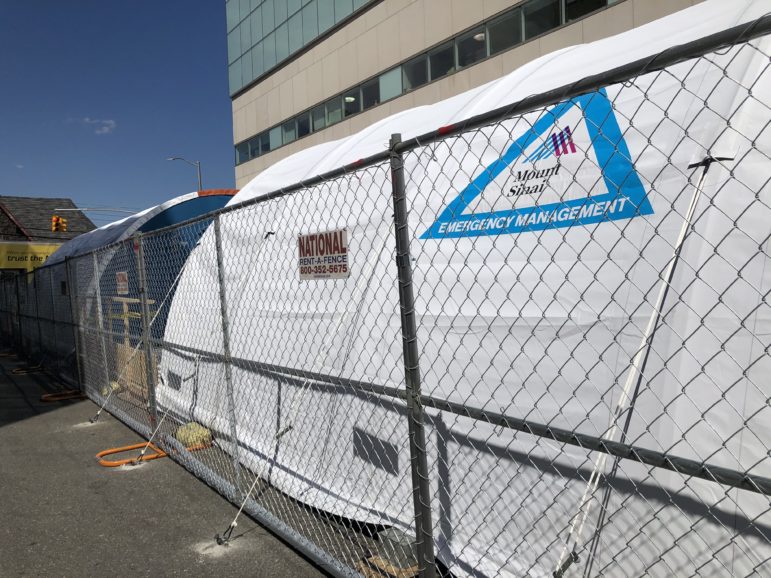City Limits used the Freedom of Information Law to obtain data from the NYC Department of Health and Mental Hygiene on weekly COVID-19 deaths by race/ethnicity from September 2020—after the first wave had just passed—to the end of July of 2022.

Jeanmarie Evelly
An emergency management tent outside Mount Sinai Queens Hospital in Astoria at the end of March 2020.
At the onset of the pandemic in March 2020, it took over a month for New York City to release the first detailed data on deaths by race and ethnicity in the city, which showed that COVID-19 was twice as deadly for Blacks and Latinos than white New Yorkers.
Since then, the city has been publishing and updating information related to deaths broken down by race/ethnicity, but doing so by death rate—the number of deaths for every 100,000 people in a given group—without a total number or date to show what weeks have been the most lethal for a specific population.
City Limits used the Freedom of Information Law to obtain data from the NYC Department of Health and Mental Hygiene for weekly COVID-19 deaths by race/ethnicity from September 2020—after the first wave of spring 2020 had passed, and as the second peak of cases was about to hit the city that fall—to the end of July of 2022.
The data set includes both confirmed COVID-19 deaths (classified as such after a positive result from a molecular test) and probable COVID-19 deaths (when the cause of death on the death certificate is COVID-19 or similar, but without a positive molecular test on record); deaths of residents of congregate settings (long-term care facilities and correctional facilities).
But it’s not the complete picture. Racial and ethnic groups that saw four or fewer deaths on a given week were not included in the dataset to protect patient confidentiality, the Health Department notes. The hard numbers alone—which totaled 6,069 deaths among white residents, 4,309 among Hispanic/Latinos, 4,265 among Black/African Americans and 1,907 among Asian/Pacific Islanders—also don’t account for population differences across those groups.
According to census data, New York City’s population is approximately 42 percent white, 24 percent Black or African American, 29 percent Hispanic or Latino and 14 percent Asian. Since the pandemic began, the city’s Hispanic/Latino population has endured the highest rate of death when factoring population numbers in, followed by Black residents, then white and Asian American New Yorkers, respectively, Health Department data shows.
“Differences in health outcomes among racial and ethnic groups are due to long-term structural racism not biological or personal traits,” the Department said as part of the response to City Limits’ data request.
“Structural racism—centuries of racist policies and discriminatory practices across institutions, including government agencies, and society—prevents communities of color from accessing vital resources (such as health care, housing and food) and opportunities (such as employment and education), and negatively affects overall health and well-being,” the department added.
The picture that emerges from the preliminary data obtained by City Limits, though imperfect, is that the first wave was devastatingly lethal for Black and Latino residents, and the disparities continue to the present day, when the virus has killed Black and Latino people at 1.6 the rate that it has killed white people, according to the city’s latest data.
The city saw two major peaks in COVID deaths during the nearly two-year period the data represents: the first in late January and early February of 2021, when several weeks surpassed 500 fatalities. The deadliest period took place at the start of this year, when the omicron variant led to a surge in cases, and there were nearly 900 deaths during the week of Jan. 15 alone.
On Wednesday, Gov. Kathy Hochul announced the end of mask mandates on public transportation, making the usage optional—yet encouraged—during a week when more than a dozen people died in the city.
Each bar in the graph below represents data for the full week noted.








